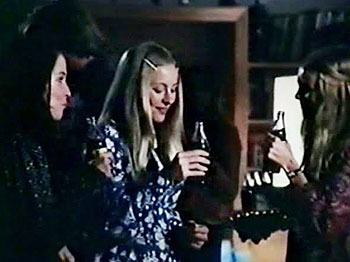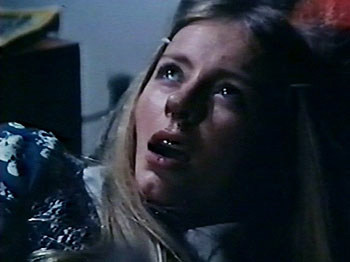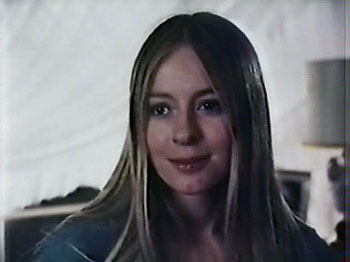From True To False And Back Again: Go Ask Alice
Published on July 30th, 2011 in: Issues, My Dream Is On The Screen, Retrovirus, TV |“This motion picture is based on the authentic diary of a 15-year-old American girl. The only alterations have been those necessitated by considerations of length and acceptability for family viewing.”
—Opening credits of Go Ask Alice
I kept diaries from the age of 10 or 11 through college and I still have almost every one of them. They were absolutely vital to my sanity for most of my teenage years, filled with details I would never have dared to tell anyone. It felt safer somehow to write it down.

Has the Internet made written diaries obsolete, or is the privacy they once afforded no longer relevant? Granted, some sites allow for at least a modicum of privacy through “Friends Only” posts (though nothing is ever truly private on the Web), but f you’re under the age of 30 and you spend any time on Tumblr, you might be taken aback by some bloggers’ accounts of their daily lives.
Go Ask Alice, the 1973 made-for-TV movie, was based on the book of the same name. I didn’t read it for the first time until I was a teen in the ’80s, but it was originally published in 1971 and credited to “Anonymous,” claiming to be the actual diary of a 15-year-old girl (whose name was kept private). Later, this claim was debunked when the book’s “editor” Beatrice Sparks, published several more similarly anonymous diaries such as Jay’s Journal (1978) and It Happened to Nancy (1994). Cynics and recreational drug users found some of the book’s more lurid descriptions improbable and/or amusingly naïve, and called out the book for what it was—an attempt to warn teens about the dangers of drug use.
So does this invalidate the effectiveness of either the book or the film? Does Go Ask Alice still matter, if it ever did?
Go Ask Alice takes place over two years in the life of the unnamed protagonist, introducing us to her as a shy, awkward, fairly typical teenage girl who gets dosed with LSD at a party and eventually turns to dealing drugs and prostitution. Naturally, a 73-minute film cannot capture the book’s most emotionally affecting details, such as the girl’s relationship with her grandparents (and their eventual deaths), and it omits a lot of the events that propel her to run away twice and eventually end up institutionalized after a bad trip. (Additionally, for narrative reasons, she is named “Alice” in the movie version.)

Although much of this is quite compelling in the original text, the timeline is shortened in the film so that it seems like Alice takes her first trip one day and within a week is already pushing drugs on grade schoolers. This makes the old cliché of “it leads to stronger stuff” seem truer than ever; this trope was used to comic effect in the episode of Taxi where Reverend Jim recalls being a straight arrow until someone gave him pot brownies.
Interestingly, the film also omits all but the most oblique references to Alice’s sexual encounters, which are discussed frequently (though not explicitly) in the book. One particularly unpleasant incident which translates quite effectively onto the screen, however, is the one in which Alice and Chris hook up with a swinger couple who proceed to drug and rape them repeatedly.
In the movie, this is never even discussed until Alice has a flashback of some sort when talking to a priest at a shelter. We see a man and a woman (listed in the credits as “Male Sadist” and “Female Sadist”) holding up pills and leering. The camera then cuts to Alice and her friend Chris kneeling on the floor in front of them, wearing dirty T-shirts and little else. Then one of the girls crawls off screen and we hear creepy laughter and screaming. Granted, this isn’t on the same level of disturbing as another infamous made-for-TV movie, Born Innocent (1974), but it’s quite disquieting nonetheless, particularly in its ambiguity.
Towards the end of the film when Alice is reunited with her family after she has run away, she is talking to her love interest, Joel, and mentions all the men she’s been with when she was high. The scene could have come across as preachy but lead actress Jamie Smith-Jackson makes Alice’s shame and hesitation believable. Although this was likely due in some part to TV Standards and Practices, such restraint strikes the perfect balance of confession and suggestion, especially when compared to the overwhelmingly prurient tone of the last few seasons of shows like Criminal Minds and Law & Order: SVU.

Even if you haven’t read the book or can overlook the omissions of the film, the viewer is drawn into Alice’s story. Much of this is due to the casting of mostly unknowns with a few exceptions: An almost-unrecognizable (except for the acting) William Shatner as Alice’s dad and Andy Griffith as the priest. For the most part, the film feels realistic due to its quasi-documentary camera style, naturalistic (and likely low budget) mise en scene, and frequent voiceovers from Alice. The music is also contemporary to the time period, and although all of the songs performed are covers of the originals (such as Bowie’s “It Ain’t Easy”), they are still effective at setting the tone.
One scene that is rendered fascinating by the casting: Mackenzie Phillips appears in her first screen role as Doris, a teenage prostitute whose been accompanying Alice on part of her journey. Seeing her so young and (probably at that time) innocent brings to mind the troubled path down which she’s stumbled ever since.
Alice has a younger brother Tim, who doesn’t have much dialogue, but whose presence is important. He clearly knows that Alice and her friends are high at her birthday party, even though her parents don’t. And his disappointed face when she lies to them that she isn’t using drugs says more than any dialogue could. When he walks her to school so she can avoid being hassled by her doper ex-friends, you can sense his admiration and concern as well as her anxieties.
There are only a couple of parts of the film that don’t quite gel. One is Alice’s speech to the priest when she claims that she “can’t stay off it,” especially after it’s revealed she’s given him her diary to read. Although this is a tidy way for her to convey her past misdeeds to him without showing a montage, it contradicts much of what we’ve come to know about Alice. Later, when her former friend Jan comes to the house where Alice is babysitting, there’s more than a bit of drug-induced hyperactive overacting on Jan’s part.
Did Go Ask Alice (book or movie) scare kids into avoiding drugs? It probably did then, although teenagers watching it now would just laugh and consider it campy. Snopes has tried to debunk the book by pointing out inconsistencies and inaccuracies in both the setting and timeline, but these are so minor that they don’t take away from the book’s overall poignancy (and in fact, are rendered moot in the film). Their critique of the sophisticated writing style, though valid, comes across as even less substantial and perhaps unsympathetic, particularly New York Times writer’s Mark Oppenheimer’s “how to write a teen morality novel” synopsis.
But is Beatrice Sparks as irresponsible and duplicitous as James Frey or JT LeRoy? Although Sparks was a Mormon youth counselor and therapist, there is scarcely any religious moralizing in the book, at least any that seems forced. While Alice does talk about God in certain contexts, it comes across as totally natural and not heavy-handed or preachy. Interestingly, the one religious figure in the movie, Andy Griffith’s priest, even tells Alice that church and God won’t help her at this point; it’s up to her to make the choice to get clean.
No, Go Ask Alice isn’t high art or a vital chapter in the annals of film or literature. As a document of the time period and of the trials and tribulations of teenagers, however, it is still worth reading and watching and will probably ring at least partially true to anyone who kept a diary before the Internet came along.
Time limit is exhausted. Please reload the CAPTCHA.